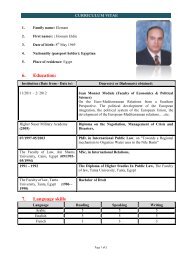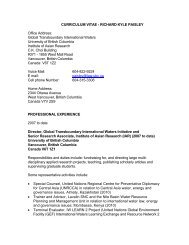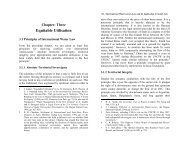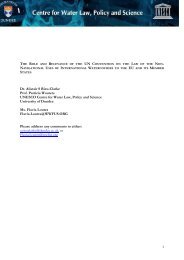Upreti, Trilochan, International Watercourses Law and Its Application ...
Upreti, Trilochan, International Watercourses Law and Its Application ...
Upreti, Trilochan, International Watercourses Law and Its Application ...
Create successful ePaper yourself
Turn your PDF publications into a flip-book with our unique Google optimized e-Paper software.
224 / <strong>International</strong> <strong>Watercourses</strong> <strong>Law</strong> <strong>and</strong> <strong>Its</strong> <strong>Application</strong> in South Asia Prospects <strong>and</strong> Problems of Nepalese Water Resources / 225law. Under the concept of equitable utilization,watercourse states are entitled to a reasonable <strong>and</strong>equitable share of the benefits of an internationalwatercourse. It would seem to follow, therefore,that when a watercourse state does or refrains fromdoing an act that confers a benefit on another statesharing the watercourse, the latter state is under anobligation to share the benefit equitably with theformer. The treaty practice of states supports theexistence of this principle of sharing benefit. As itis well known, the principle of downstream benefitsis dealt with explicitly in the Columbia Treaty (542U.N.T.S. 244). And many other treaties provide forthe return, either in kind or in cash, of a share of thebenefits received as a result of the acts done inanother state.” 135The damming <strong>and</strong> storage of flood <strong>and</strong> snow fed waters of theColumbia River in Canadian territory made it possible toaugment <strong>and</strong> regulate an enormous volume of water, fromwhich a series of hydropower stations were constructed toharness a huge amount of hydropower in US territory.Furthermore, flood damage was controlled, <strong>and</strong> substantialharm was thereby prevented. In addition, the regulated flow ofthe waters was used for irrigation in the US in times of need, toincrease agricultural productivity. However, a considerablechunk of Canadian territory was submerged by these reservoirs,<strong>and</strong> forests, flora <strong>and</strong> fauna were extinguished; also a bigamount of money was spent in order to construct thesestructures. The United States agreed to pay US $ 64 million fordownstream benefits accrued in their territory as a result of135 Report of the Panel on Nepal’s <strong>International</strong> Rivers, comment on “APosition Paper on The Rights, Duties <strong>and</strong> Obligations of Upper <strong>and</strong>Lower Riparian Countries for Sharing Water Resources” a PositionPaper of Nepal submitted to the Nepalese Parliament by a team headedby the author in 1998. Annex 2, pp. 2-5 (a copy of the report is one thefile with the author).Canadian storage; the power generated by these augmentedwaters was divided equally with Canada, <strong>and</strong> the Canadianshare was later bought by the US at the agreed price of US$254 million. 136 The money was provided to Canada in advanceso that she could undertake the works. The benefits accruingfrom these works were classified as power, flood control <strong>and</strong>irrigation <strong>and</strong> were each shared equally. However, it tookalmost twenty years to convince the United States about thesebenefits <strong>and</strong> conclude this treaty. 137Bourne, McCaffrey <strong>and</strong> Utton have given a few instances ofdownstream benefits from the several treaties concludedbetween riparian states. Those practices show that the conceptwas practised from the early nineteenth century, <strong>and</strong> has beenwidely recognised; as a result of such practice, it has becomethe rule of customary law. 138 Moreover, as further argued bythe above group of professors:136 R. W. Johnson, “The Columbia Basin” in A. Garretson, et.al (eds), The<strong>Law</strong> of <strong>International</strong> Drainage Basins, New York: Oceana Pub., 1967p. 228.137 Ibid. pp. 167-24; also see C. B. Bourne, “The Columbia RiverControversy” (1959), in 37 CBR, pp. 444- 472.138 Supra note 135: The authors refer to six examples: i) the 1919 Treaty ofVersailles gave France the exclusive right to use the Rhine for powerproduction in return for paying Germany one-half the value of the energyproduced; ii) the 1921 Barcelona Convention provides for sharing downstreambenefits, though where a state is required to improve or maintain a river, it isentitled to a reasonable contribution of costs; iii) a 1926 agreement betweenSouth Africa <strong>and</strong> Portugal allowed South Africa to make diversion works onthe Kunene River in Angola but required it to compensate Portugal (a 1969treaty between the parties also provided for a sharing of benefits from theconstruction of a dam); iv) the 1977 Rhine Chlorides agreement states that theNetherl<strong>and</strong>s is to pay a share of the cost to France of disposing of waste salts ina manner other than discharging them into the river (the authors note that “thisis a particularly striking example since it could be argued that France had aduty to avoid significant pollution harm to the Netherl<strong>and</strong>s apart from thetreaty”); v) the Lesotho Highl<strong>and</strong>s Project treaty requires South Africa to pay asignificant share of construction costs for works undertaken in Lesotho inreturn for downstream benefits; vi) the 1977 treaty between Czechoslovakia<strong>and</strong> Hungary (which was the subject of the Gavcikovo-Nagymaros case)provides for a dam <strong>and</strong> hydro plant to be located in Czechoslovakia (nowSlovakia) with Hungary to receive power <strong>and</strong> flood control benefits.












